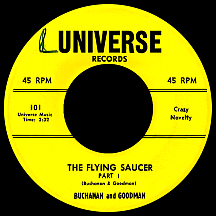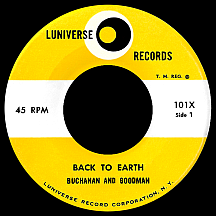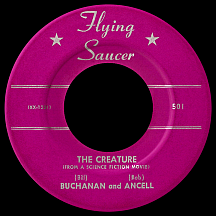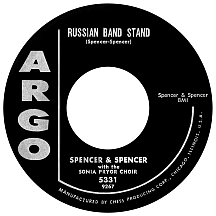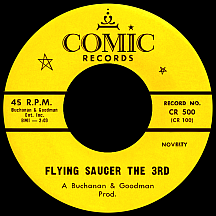BUCHANAN AND GOODMAN
'The reports of a flying saucer hovering over the city have been confirmed!' Practical jokesters Bill Buchanan and Dickie Goodman eased the paranoia a bit during the UFO era of the 1950s with a truly bizarre and popular series of novelty records that tested the nervous systems of certain music industry insiders. With the relatively recent emergence of magnetic tape, an unruly few got their kicks editing music and sound effects, creating strange new recordings using razor blade cut-and-splice methods. In 1955, Carl Weismann of Denmark put together what he called a "Canine Chorus" using random dog barks, crediting the trick to a fictional act he called, simply, The Singing Dogs. In the summer of '56, Bill and Dickie took a greater risk with their comedy creation, later categorized as a "break-in" (or "cut-in") record, built around bits and pieces of actual hit songs. Turns out certain copyright owners didn't take too kindly to such a display of blatant infringement.
Bill and Dickie had known each other since they were kids growing up on Long Island. By the mid-'50s they had taken to pounding the pavement in New York City, making futile attempts at establishing themselves as songwriters. They started a publishing firm under the Buchanan and Goodman name, but it was an ultra-small-time operation; they made their contacts from a pay telephone inside Hanson's Drug Store at 50th street and 7th Avenue, a popular hangout for aspiring actors, singers and wannabe celebrities. Inspiration came in the summer of '56 by way of The Platters' hit "The Great Pretender" and its line 'Too real is this feeling of make believe...' Not just real, man, but...TOO REAL! It reminded them of those Flying Saucers Are Real tabloid headlines (that had also been the title of a paperback book by Donald Keyhoe published in 1950).
Buchanan played the part of an Alan Freed-like disc jockey and Goodman mocked man-on-the-street interviews as "John Cameron Cameron" (skewering newsman and professional celeb John Cameron Swayze). Quick snippets from current rock and R&B records were sprinkled throughout the two-part, four-and-a-half minute recording (Dickie: "What would you do if the saucer were to land?" Little Richard, from "Long Tall Sally": 'Duck back in the alley!') Bits and pieces of hits by Fats Domino, The Penguins, Smiley Lewis, Carl Perkins, Chuck Berry and even Elvis Presley were spliced into the wild, at times incomprehensible, reel-to-reel tape. Sound effects including crowd noises, drum stings and speeded-up Martian voices (supplied by Goodman) were all part of the craziness, including one intentionally skipping record (The Platters, from "(You've Got) The Magic Touch": 'Here I go reeling, uh-oh (skip) uh-oh (skip) uh-oh (skip) uh-oh...' Buchanan: "That was the Clatters again with their big one, UH-OH!" Juvenile? Amateurish? Maybe, maybe not. It couldn't possibly appeal to anyone but children or the hopelessly deranged, right?
They took the master reel (the only copy they had) around to most of the New York-based record companies, getting doors slammed in their faces or being thrown into the street with each attempt. Then they went the direct route, dropping by radio station WINS one night in July with the tape. Freed himself played it and listeners flipped. The buzz on the street the next day was, "Hey, did you hear that weird thing they played last night about UFOs and Elvis?" Suddenly the guys had no problem getting record companies interested. George Goldner, head man at the Roulette/Gone/End group of labels, offered to release it, setting them up with their own label, Universe, in the process. A local pressing plant got busy manufacturing copies of "The Flying Saucer," but then one of Goldner's associates found out there was already a Universe label in existence, so George, Bill, Dickie and a few of the company's staff members headed to the plant for an after-hours project: hand-lettering an "L" before "UNIVERSE" on each of approximately two thousand 45s and 78s already pressed...that's right, four thousand Ls etched into the labels the hard way, with ball-point pens! In later years a record company would probably just melt them all down and start over, but in 1956, why throw away a thousand bucks in potential profits? Besides, demand was hot...those records had to go out right away!
"The Flying Saucer," on the Luniverse label, invaded the nation's airwaves very quickly. Some radio stations were hesitant to play the record, afraid it might cause hysteria similar to what happened when Orson Welles broadcast The War of the Worlds just before Halloween in 1938 (though the public probably wouldn't buy into a gimmick like that again so easily). By the end of August the single was number three on both the Billboard and Cash Box charts, just behind two of the victims of Buchanan and Goodman's warped sense of humor: Elvis (on top with "Hound Dog") and the Platters (number two with "My Prayer"). Within a couple of months, sales had cruised past the million mark...and that's not counting the poor quality bootlegged knockoffs (not bothering to show any artist credit) that appeared on the Radioactive label (Radio Active on some pressings). Luniverse even released an odd variation of its own titled "Back to Earth," which was nothing more than "The Flying Saucer" with a different title, undoubtedly tricking some fans into purchasing the record - again!
Almost immediately our heroes found themselves in hot water. Before the end of July an attorney, acting on behalf of various publishers through the Harry Fox Agency, informed them he planned to file an infringement suit in the U.S. District Court. Goldner suddenly disclaimed any connection, leaving Bill and Dickie on their own. They hired a lawyer but nothing happened right away; label owners and publishers were uncertain as to how far to push the envelope, seeing it as a one-shot fluke. No one really thought the two would dare release any more of these blasphemous affronts/assaults on the record industry/music fans! One wrinkle: some music publishers were miffed at being excluded from the record; such forward-thinkers were more concerned with the positive aspects of free promotion. Several records had shown upward sales movement thanks to the exposure gained by a few seconds on the novelty disc. Buchanan and Goodman settled with the Fox agency by agreeing to pay a fraction of a cent per song excerpt for each disc sold; the pressure tactic seemed to have worked. Record labels and publishers figured that would be the end of it.
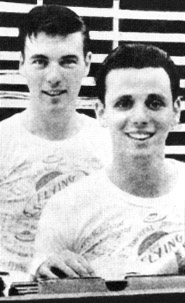
Perhaps they hadn't noticed all the imitation "Flying Saucer" records that had started coming out within weeks of the original. Sid Noel and his Outer Spacemen recorded a version for Aladdin, using nearly the same script as B&G's original but with rerecorded snippets on some, but not all, of the hit songs used; Freed wasted no time in putting out a similar recording, "The Space Man" on Coral, supported by an impressive cast of established artists (the single's credit showed Alan Freed, Steve Allen, Al "Jazzbo" Collins and the Modernaires with George Cates' Out of Spacers), performing their own renditions of each brief excerpt...just to be safe. Other perpetrators were a bit more original in execution; Syd Lawrence and Friends released "The Answer To The Flying Saucer U.F.O. (Men From Mars)," going to the next level of purported piracy by using clips of "The Flying Saucer" on their record, challenging Buchanan and Goodman to 'Sue us later, alligator!'
Still more "Saucer"-inspired novelties appeared, among them "Out of This World With Flying Saucers" by Dave Barry with Sara Berner on RPM, "Marty on Planet Mars" by Marty on Novelty and, later, "Outer Space Looters" by The Mad Martians on Satellite. Disc jockeys around the country, after witnessing this onslaught of outer space insanity, felt they, too, could cash in with their own break-in discs. Pandora's Box had been opened...literally hundreds of break-in records, varying in quality, appeared regularly for decades afterward! But not everyone with a reel of tape and a razor blade was so narrow-minded as to stick with the sci-fi idea; break-ins began appearing on other subjects. Elvis Presley had to endure several made in his dishonor, starting with the seemingly sincere "Dear Elvis" by Audrey on the Plus label, which hit the charts in September, the first non-B&G record to do so. Politics, a timely fall '56 topic, got the tape-splice treatment with Jack O'Ryan and Al Tercek's "Political Circus" on Nocturne; jabs at government officials would recur for many years to come, ultimately the most common theme of the break-ins. Many, many more snippet-based mini-epics followed. No public figure was safe.
Meanwhile, the original record was so successful that Buchanan and Goodman (nicknamed "The Saucer Twins" in trade magazine reports) rented office space for Luniverse that would also house their budding music publishing enterprise...above Hanson's Drug Store! They had a telephone installed but still took calls downstairs at the pay phone. They set up another label, Eldorado, for the purpose of releasing pop and rock recordings. Signing a 14-year-old singer, Joanie Dunn, right off the bat, they also obtained the tapes of an album's worth of songs by The Del-Vikings intended for Eldorado but ultimately released on Luniverse (Eldorado folded after a couple of years without any hits).
Just as it seemed there would be no more courtroom complications, Bill and Dickie were sued by representatives of Chess and Imperial in October, while the single was still hot on the charts. The two companies had been unwilling to go along with the earlier deal made with the Fox agency and sought more than 100,000 dollars in additional damages. Imperial artists Domino and Lewis, in particular, wanted personal compensation for the use of their recordings. Ultimately, a judge ruled that Buchanan and Goodman's work was a parody, or satire, and thus was protected by U.S. law; he also pointed out that the inclusion of copyrighted songs on "The Flying Saucer" would be more likely to increase sales of those records rather than hurt them. Bill and Dickie had just gotten the green light to make more break-in records!
The second single, "Buchanan and Goodman On Trial," was a deliberate, brazen satire of their legal difficulties. The Martians from the first disc served as the jury, the duo's skills with editing sound effects and song excerpts had advanced somewhat, and the end result was perhaps the funniest of B&G's recordings (Dickie, after winning the case: 'Now what are you going to do with that summons?' Little Richard: 'Gonna Rip It Up! I'm gonna Rip It Up!'); it had a short run on the national charts in November. Their contempt obvious, they nevertheless made one adjustment after first pressings had been sent out with a line from "I'm in Love Again"; Fats Domino (or "Skinny Dynamo" as they called him) had put the greatest pressure on them during the legal proceedings, so to avoid another brush-up, they replaced the one line on second pressings with a bit involving Jim Lowe's "The Green Door." It was the duo's only acquiescence. There were no further court complications. By the end of the year, with so many other break-ins on the market, the powers that be saw no recourse but to let the fad run its course (which it didn't!).
They took a different tack with the third single, "The Banana Boat Story," integrating The Tarriers' early '57 hit "The Banana Boat Song" with popular TV commercials (and one or two made-up ones) in place of hit song snippets. Billboard called it a "nerve-wracking hodge-podge" that was "pointless" and "unfunny." It missed the charts altogether. Buchanan was ready to quit after this; he continued to stay involved in the publishing end but stopped working with Goodman. Left to his own devices, Dickie used another announcer-type for "Flying Saucer the 2nd," crediting it as A Buchanan and Goodman Production. Radio stations welcomed this reprise of the original gimmick and it became a surprise hit, reaching the top 20 in August 1957, precisely one year after the first single had caused such a sensation. Goodman milked the concept with another top 40 hit in December, "Santa and the Satellite," using deejay Paul Sherman for Buchanan's part (and giving him credit on the label below the B&G name). At about this time Bill popped up with a new partner, Bob Ancell, hitting the charts with "The Creature (From a Science Fiction Movie)," a sillier-than-ever break-in effort on (what else?) the one-shot Flying Saucer label.
Luniverse Records existed primarily for Buchanan and Goodman releases, but a couple of non-novelty recordings got the nod; R&B artist Buddy Lucas had the label's fourth release with his wild, growling "Bo-Lee" and the Del-Vikings, split into two groups by then, added to various Fee Bee, Dot and Mercury releases with the aforementioned Luniverse album and a single, "Somewhere Over the Rainbow." "The Flying Saucer Goes West" was the final B&G break-in released by the label, after which Dickie supplied the voice of "The Invisible Thing" on a novelty single by vocal group The Casual Three. It was the end of the line for Luniverse. 'Goodbye, earth people!'
But the novelty inanity didn't stop there. Buchanan put out a non-break-in remake of Phil Harris's 1950 hit "The Thing" on Goldner's Gone label, carrying on with a few other goofy offerings over the next few years and scoring one legitimate hit as a songwriter (with Bobby Vee's "Please Don't Ask About Barbara" in '62) before permanently hanging up his headphones. Goodman kept the Buchanan and Goodman name going with "Frankenstein of '59" (a minor hit) on the Novelty imprint, then teamed with Mickey Shorr for two singles as Spencer and Spencer, the first a weird Lloyd Price/Lawrence Welk culture-clash novelty, "Stagger Lawrence," followed by a gutsy Cold War satire, "Russian Band Stand," that hit the charts in May 1959. Dickie also put out "Flying Saucer the 3rd" as a B&G single on the Comic label, finding with that last effort that lightning may strike twice in the same spot, but never three times.
With the break-in craze winding down by decade's end, Dickie gave it all up to focus on his songwriting and whatever niche he could find for himself in the music biz. That hiatus lasted less than two years. In early 1961 he gave it another whirl with "The Touchables" (a sendup of ABC-TV's hot prohibition-era TV series The Untouchables) and it had a solid chart run. He was back in business and continued making "break-in" records for the next three decades until his death in 1989. These crackpot creations, that many felt should never have existed in the first place, had established an ongoing presence in the undercurrent of rock and roll. From the beginning, Dickie Goodman set the standard by which all other wacky tape-splicers are judged.
NOTABLE SINGLES:
- The Flying Saucer Part 1 /
The Flying Saucer Part 2 - 1956 - Back to Earth Side 1 /
Back to Earth Side 2 - 1956 - Buchanan and Goodman On Trial /
Crazy - 1956
by the Luniverse Sympharmonic Orchestra Conducted by
Buchanan and Goodman - The Banana Boat Story /
The Mystery (In Slow Motion) - 1957 - Flying Saucer the 2nd - 1957
as a Buchanan and Goodman prod. / - Martian Melody - 1957
by Martian Symphony Orch. - The Creature (From a Science Fiction Movie) - 1957
by (Bill) Buchanan and (Bob) Ancell / - Buchanan and Ancell Meet the Creature (From a
Science Fiction Movie) - 1957
by Buchanan and Ancell - Santa and the Satellite Part 1 - 1957
as a Buchanan and Goodman prod. with Paul Sherman / - Santa and the Satellite Part 2 - 1957
as a Buchanan and Goodman prod. with Paul Sherman - The Flying Saucer Goes West - 1958
as a Buchanan and Goodman prod. / - Saucer Serenade - 1958
by the Saucer Men - The Thing - 1958
by Bill Buchanan - Frankenstein of '59 (Part 1) - 1959
as a Buchanan and Goodman Enterprise Production with Count Dracula / - Frankenstein Returns (Part 2) - 1959
as a Buchanan and Goodman Enterprise Production with Count Dracula - Stagger Lawrence - 1959
by Spencer and Spencer - Russian Band Stand - 1959
by Spencer and Spencer with the Sonia Pryor Choir - Flying Saucer the 3rd - 1959
as a Buchanan and Goodman prod.


